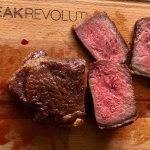Description
This reverse-sear dry-aged steak recipe gives you an evenly cooked interior with a minimal gray band and a crisp, flavorful crust. Starting low and slow in the oven and finishing with a quick, high-heat sear makes it foolproof even if it’s your first time cooking dry-aged steak.
Ingredients
For Steak:
- Steak (At least 1 inch/2.5 cm thick, ideally 1.5-2.5 inches/3.8 – 6.3 cm, or more)
- 1–2 tablespoons (15–30 ml) High-smoke-point oil
- 1 teaspoon kosher salt
- 1/2 teaspoon black pepper
- A few sprigs of fresh thyme or rosemary
- 2–3 garlic cloves
- 2 tablespoons (28g) unsalted butter
Tools:
- Cast-iron, carbon steel, or heavy-bottomed stainless steel skillet
- Oven-safe wire rack and baking sheet
- Tongs
- Meat thermometer (A leave-in probe thermometer is best for oven cooking, but an instant-read thermometer works too)
Instructions
- Prepare the Steak: Season the steak generously with kosher salt and finely ground black pepper on all sides, including the edges. Place it on a wire rack set over a rimmed baking sheet and refrigerate it uncovered for at least 1 hour, or ideally for about 4 hours to achieve a deeper flavor. Avoid salting the steak for longer than 4 hours. The longer it sits salted, the more likely it is to form a thicker gray band under the crust.
- Slow-Cook the Steak in the Oven: Preheat the oven to 225°F (107°C). Transfer the baking sheet with the wire rack and steak into the oven, and cook until a meat thermometer reads about 20°F (6°C) below your target doneness (for example, around 115°F/46 °C if you’re aiming for medium-rare). Then, remove the steak from the oven (see notes for temperature chart).
- The cooking time in the oven varies significantly depending on the steak’s thickness, so please don’t rely on the clock. The best option is to invest in a good leave-in probe thermometer. Insert the probe from the side so it reaches the very center of the steak, then set an alarm for your target temperature.
- If you only have an instant-read thermometer, start checking after about 20 minutes for thinner steaks and 30 minutes for thicker cuts (if you’re going for medium-rare).
- Sear the Steak for a Crust: Place a pan over high heat and let it heat for about 3-4 minutes. Add 1–2 tablespoons of oil and heat for another minute. Use 1 tablespoon for well-marbled cuts and 2 tablespoons for leaner cuts.
- Once the pan is hot, place the steak inside and sear it, flipping every 30 seconds for up to 2 minutes in total (1 minute per side, with a total of 4 flips). Each time you flip the steak, gently press it with tongs to ensure even contact with the pan’s surface. Optionally, you can also sear the edges for up to 30 seconds. When done, remove the steak from the pan and move on to the aromatics.
- Prepare the Aromatics: In the same hot pan, add a few sprigs of fresh herbs and peeled garlic cloves. Keep the heat at medium-high and sear the garlic until it turns lightly golden brown. Then reduce the heat to medium-low, add the butter, and let it melt together with the aromatics. Once the butter mixture is ready, move on to the final step: serving.
- (Optional) Instead of preparing the garlic, herbs, and butter in the pan, you can simply place a thin slice of compound butter on top of the steak immediately after searing and let it melt. It’s an easier method, but it does require making the compound butter in advance.
- Serve Immediately: Slice the steak thinly, then pour the melted butter from the pan over the top just before serving. Don’t forget the leftover herbs and seared garlic; add those too for extra flavor.
- Unlike most pan-seared steak recipes, you don’t need to let the steak rest after searing with this reverse sear method. If you skip the aromatics, simply slice the steak immediately after searing and serve it right away.
Notes
Note: Instead of butter, garlic, and fresh herbs, you can use compound butter. Simply place a thin slice over the steak immediately after searing, and it’ll melt into the meat, adding the same rich flavor with less effort.

